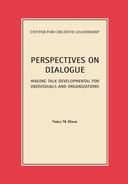0%
17Chapters
0-1Hours read
0kTotal Words
Table of Contents
- Cover
- Title Page
- Copyright
- Table of Contents
- Preface
- Acknowledgments
- Introduction
- Talk and Development
- Five Perspectives on Dialogue for Development
- Practical Observations on Dialogue
- A Definition
- The Purpose of Dialogue
- The Role of Others in Learning
- People Already Know How to Have a Dialogue
- Dialogue Is a Relationship
- Dialogue Can Offset the Instrumental Nature of Work Relationships
- Dialogue Affirms the Intellectual Capability of Ordinary Human Beings
- The Outcome of Dialogue Is Unpredictable
- Dialogue Is Paradoxical
- Examples of How Dialogue can be Incorporated into Work Processes
- Conclusion
- Appendix A
- Appendix B: The Conditions of Dialogue
- Bibliography
